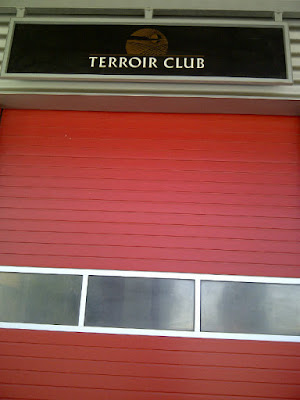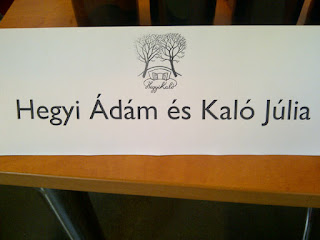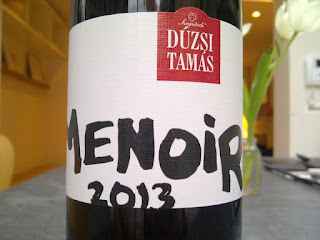On a business trip to Budapest recently we took time to check two serious wine shops, Selection.hu for the wines of Kertesz Pince and Terroir Club, the agents for Oszkar Maurer. We have sung the praises of both these producers already in this blog and the time had come to investigate bottles not stocked by Hungaricum, the Hungarian wine (and food) duty free shop at the airport - winner of the Slotovino best Airport Duty Free.
In the days of our visit Hungary felt under siege by the unfortunate Syrian and other refugees trying to get to Germany so the name Terroir Club had an ironic connotation, especially in view of something almost shocking that happened later.
First things first: after a long taxi ride to Obuda - the third city united with Buda and Pest to form Budapest on November 17th, 1873 (until our visit we had thought this was just Buda with some Hungarian prefix) - we came to an industrial estate and a firmly shut rolling metal door (above). Oh dear, was this one of our goose chases ending at the offices of an online company only?
No, fortunately it was a retail shop, venue for tasting and warehouse all in one. With the taxi waiting, we had a quick tour d'horizon and came out with some Maurer including
a white made from Szeremy Zold (Green of Szeremi) a discovery for us, turning out to be a major one,
and something called Bakator. We weren't sure if this was a grape variety or the name of a blend but we believe Piros Bakator is an old Hungarian variety whereas white Bakator is actually Ezerjo.
Zoltan who had helped us mentioned that there was a tasting at 5.00pm. We were tempted to return on the way to the airport because he said Maurer would be there with further wines from his vineyards which are situated across the border in the Vojvodina province of Serbia where there used to be a sizable Hungarian community, after 100 years down from about 28% to 13%.
We asked Zoltan if he had any Menoir (aka. Medoc Noir or Kekmedoc), a native Hungarian variety from Eger making a truly funky red wine with Muscat flavours, he said not but what he did have was Turan - a Hungarian crossing from Menoir among others (Bikaver 8 x Kadarka/Gardonyi Geza x Menoir). So we took a bottle of that as you would.
The present vintage (12%) was more neutral than the one we had tasted in May 2014 (13%) but it is still a nice wine even if the hopes we had had for this grape will perhaps not be realized. It has a reputation for neutrality which we could not have imagined on that one exceptional showing. Perhaps Kiralyleanyka has to be over 12% to realize its personality?
There were plenty of other items of interest though. One which caused amusement was the marketing of wine from Szekszard as Sexardique and others from this region with an image of the young Franz Liszt. Liszt was a very attractive young man as well as one of the greatest pianists who ever lived and a fine composer. His love life was such that he felt the need later on to take holy orders and became the Abbe Liszt.
It is not known if the Hungarian 'Madmen' were aware of the cockney rhyming slang aspect of his name but there he was, very much harnessed to the promotion of Sex - 'ard wines. Should go down well with the Stag parties and Hen nights of Budapest courtesy of Easyjet, Ryanair and Wizz Air.
Next, we added two whites we had tried previously in the hope of either re-enforcing our prejudices or having them overturned: a Juhfark and an Ezerjo.
Back at Terroir Club at 5.00pm, we found the place already in full swing. That is when we learned that Oszkar Maurer had become a victim of Hungary's tightening of its border controls. He had simply not been able to cross the border from Serbia so we were unable renew the contact we had made in May 2014 at the RAW wine fair.
Our sadness at this news was a little bit alleviated by a heartening discovery though. The wines of Hegyi Adam and Kalo Julia. Adam and Julia are a young married couple who make astounding natural wines including their own Turan with which we fell in love. Julia's father Imre Kalo is by all accounts a marvelous character known various as the wild man of Hungarian wine and Hermit of Szomolyai. Google him and you will see! We are trying to devise ways of visiting him ourselves one day.
HegyiKalo had a Turan of their own: Tiszta Szivvel (Pure Heart). One taste and we were captivated.
Their other wines are known as Oroksegul (Heritage) of which the white is a blend of Riesling, Leanyka and Gruener Veltliner and the red, Turan (60%) and Cabernet Franc (40%). there is another red blend called Cseresznyeeres (Ripening Cherries) from a local crossing Medina (aka Medea), a crossing of Seyve Villard and Menoir.
Over to Hungaricum at Liszt Ferenc Airport with a good hour to check out the Hungarian wines on offer there. An hour is a minimum amount of time for this exercise.
We first laid our hands on Gedeon's Arany Sarfeher. This had been seen last year but here was our first chance to buy a bottle. Arany means Gold, Sar means mud and Feher is white.
Next a very inexpensive but quite marvelous Portugieser from Frittmann
At that point we needed some help as previously we had bought a delicious Menoir at this shop but on this occasion it was nowhere to be found.
Without much optimism we asked the chap in charge and he went to the shelves but returned empty handed. He didn't give up though and had a good old check on the computer. This pointed to there being a bottle in stock but he said it had either been sold or misplaced. Still on a mission, he finally went over to a corner where he picked out this beauty from behind some other bottles. Now that's service for you! Our delight would have been complete if he could have plucked Oszkar Maurer and the poor souls trying to cross the border out from behind the border with Serbia.












































